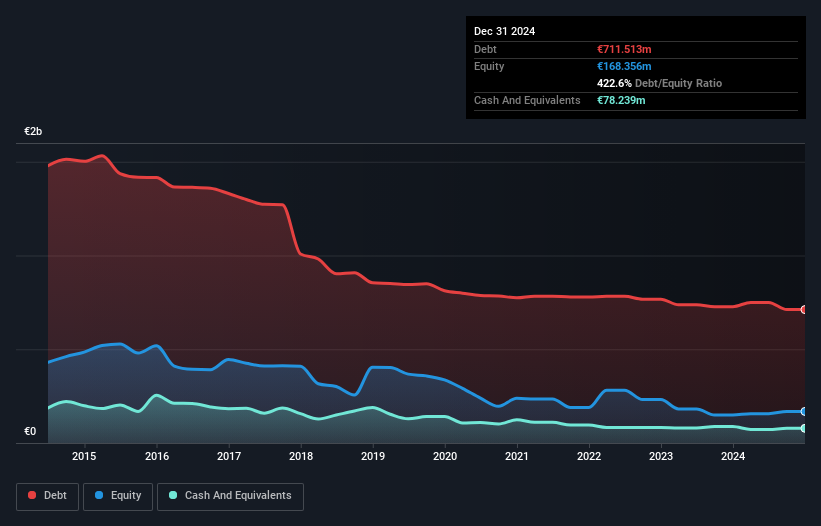Legendary fund manager Li Lu (who Charlie Munger backed) once said, 'The biggest investment risk is not the volatility of prices, but whether you will suffer a permanent loss of capital.' So it seems the smart money knows that debt - which is usually involved in bankruptcies - is a very important factor, when you assess how risky a company is. We can see that Teixeira Duarte, S.A. (ELI:TDSA) does use debt in its business. But the more important question is: how much risk is that debt creating?
We've discovered 3 warning signs about Teixeira Duarte. View them for free.Why Does Debt Bring Risk?
Generally speaking, debt only becomes a real problem when a company can't easily pay it off, either by raising capital or with its own cash flow. In the worst case scenario, a company can go bankrupt if it cannot pay its creditors. However, a more frequent (but still costly) occurrence is where a company must issue shares at bargain-basement prices, permanently diluting shareholders, just to shore up its balance sheet. Of course, plenty of companies use debt to fund growth, without any negative consequences. When we examine debt levels, we first consider both cash and debt levels, together.
What Is Teixeira Duarte's Debt?
The chart below, which you can click on for greater detail, shows that Teixeira Duarte had €711.5m in debt in December 2024; about the same as the year before. On the flip side, it has €78.2m in cash leading to net debt of about €633.3m.

A Look At Teixeira Duarte's Liabilities
According to the last reported balance sheet, Teixeira Duarte had liabilities of €645.5m due within 12 months, and liabilities of €644.9m due beyond 12 months. Offsetting these obligations, it had cash of €78.2m as well as receivables valued at €194.8m due within 12 months. So it has liabilities totalling €1.02b more than its cash and near-term receivables, combined.
This deficit casts a shadow over the €84.8m company, like a colossus towering over mere mortals. So we'd watch its balance sheet closely, without a doubt. At the end of the day, Teixeira Duarte would probably need a major re-capitalization if its creditors were to demand repayment.
See our latest analysis for Teixeira Duarte
In order to size up a company's debt relative to its earnings, we calculate its net debt divided by its earnings before interest, tax, depreciation, and amortization (EBITDA) and its earnings before interest and tax (EBIT) divided by its interest expense (its interest cover). Thus we consider debt relative to earnings both with and without depreciation and amortization expenses.
Weak interest cover of 1.5 times and a disturbingly high net debt to EBITDA ratio of 6.4 hit our confidence in Teixeira Duarte like a one-two punch to the gut. This means we'd consider it to have a heavy debt load. One redeeming factor for Teixeira Duarte is that it turned last year's EBIT loss into a gain of €71m, over the last twelve months. The balance sheet is clearly the area to focus on when you are analysing debt. But you can't view debt in total isolation; since Teixeira Duarte will need earnings to service that debt. So if you're keen to discover more about its earnings, it might be worth checking out this graph of its long term earnings trend.
But our final consideration is also important, because a company cannot pay debt with paper profits; it needs cold hard cash. So it's worth checking how much of the earnings before interest and tax (EBIT) is backed by free cash flow. During the last year, Teixeira Duarte burned a lot of cash. While investors are no doubt expecting a reversal of that situation in due course, it clearly does mean its use of debt is more risky.
Our View
To be frank both Teixeira Duarte's conversion of EBIT to free cash flow and its track record of staying on top of its total liabilities make us rather uncomfortable with its debt levels. Having said that, its ability to grow its EBIT isn't such a worry. Taking into account all the aforementioned factors, it looks like Teixeira Duarte has too much debt. That sort of riskiness is ok for some, but it certainly doesn't float our boat. There's no doubt that we learn most about debt from the balance sheet. But ultimately, every company can contain risks that exist outside of the balance sheet. Case in point: We've spotted 3 warning signs for Teixeira Duarte you should be aware of, and 2 of them are concerning.
If, after all that, you're more interested in a fast growing company with a rock-solid balance sheet, then check out our list of net cash growth stocks without delay.
Valuation is complex, but we're here to simplify it.
Discover if Teixeira Duarte might be undervalued or overvalued with our detailed analysis, featuring fair value estimates, potential risks, dividends, insider trades, and its financial condition.
Access Free AnalysisHave feedback on this article? Concerned about the content? Get in touch with us directly. Alternatively, email editorial-team (at) simplywallst.com.
This article by Simply Wall St is general in nature. We provide commentary based on historical data and analyst forecasts only using an unbiased methodology and our articles are not intended to be financial advice. It does not constitute a recommendation to buy or sell any stock, and does not take account of your objectives, or your financial situation. We aim to bring you long-term focused analysis driven by fundamental data. Note that our analysis may not factor in the latest price-sensitive company announcements or qualitative material. Simply Wall St has no position in any stocks mentioned.
About ENXTLS:TDSA
Teixeira Duarte
Operates in the construction, concessions and services, real estate, hospitality, distribution, and automotive sectors in Portugal, Angola, Brazil, Mozambique, and internationally.
Solid track record and slightly overvalued.
Market Insights
Community Narratives



